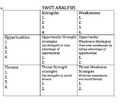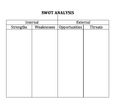SWOT Analysis facts for kids
SWOT Analysis is a helpful tool that lets you look closely at a project, a business, or even a personal goal. It helps you find out the Strengths, Weaknesses, Opportunities, and Threats that might come up. Think of it as a way to check everything around you, both inside and outside your group or yourself.
This method is great for understanding what's going well and what needs work. It also helps you spot chances to grow and things that could cause problems. A person named Albert Humphrey created this technique. He led a research project at Stanford University in the 1960s and 1970s. He used information from big companies like those on the Fortune 500 list to develop it.
Contents
What is a SWOT Analysis?
A SWOT Analysis is like a special checklist. It helps you plan better for anything you want to do. It makes you think about four main areas. These areas are Strengths, Weaknesses, Opportunities, and Threats.
This tool helps you understand your current situation. It also helps you get ready for the future. Many different groups use it, from big companies to small school clubs.
Why Use SWOT?
Using a SWOT Analysis helps you make smarter choices. It gives you a clear picture of what you are good at. It also shows what you need to improve.
- Better Planning: It helps you create a good plan for your project or business.
- Spotting Chances: You can find new chances to succeed.
- Avoiding Problems: It helps you see possible problems before they happen.
- Making Decisions: It gives you facts to make strong decisions.
The Four Parts of SWOT
Each letter in SWOT stands for an important part of the analysis. These parts are split into two groups: internal and external.
Internal Factors: Strengths and Weaknesses
Internal factors are things you can control. They come from inside your team, business, or yourself.
Strengths
Strengths are the good things you have. They are what you do well. These are things that give you an advantage.
- Examples:
* Having a strong team. * Being very good at a certain skill. * Having a lot of money for a project. * A good reputation or brand name.
Weaknesses
Weaknesses are the things you don't do so well. They are areas where you could improve. These might hold you back.
- Examples:
* Not having enough people to help. * Lacking certain skills or knowledge. * Not having enough money. * Old equipment or technology.
External Factors: Opportunities and Threats
External factors are things happening outside your control. They come from the world around you.
Opportunities
Opportunities are good situations outside your control. They are chances you can use to your benefit. These can help you grow or succeed.
- Examples:
* New technology becoming available. * A new trend that people like. * Less competition in your area. * New laws that help your business.
Threats
Threats are bad situations outside your control. They are things that could cause problems. These might make it harder to reach your goals.
- Examples:
* New competitors starting up. * Changes in what customers want. * Economic problems. * New laws that make things harder.
How to Do a SWOT Analysis
Doing a SWOT Analysis is quite simple. You can do it by yourself or with a group.
- Step 1: Gather Information: Collect facts about your project or business. Look at both internal and external things.
- Step 2: List Strengths: Write down everything you do well. What makes you special?
- Step 3: List Weaknesses: Write down what you need to improve. What holds you back?
- Step 4: List Opportunities: Look at the world around you. What new chances are there?
- Step 5: List Threats: What outside problems could affect you?
- Step 6: Plan Your Next Steps: Use what you learned to make a plan. How can you use your strengths and opportunities? How can you fix weaknesses and deal with threats?
Who Uses SWOT?
Many different people and groups use SWOT Analysis.
- Businesses: Companies use it to plan their future and understand their market.
- Schools and Clubs: They can use it to plan events or improve their activities.
- Individuals: You can even use it for your own personal goals, like choosing a career or planning a big project.
It's a flexible tool that helps anyone think more clearly about their goals.
Images for kids
See also
 In Spanish: Análisis FODA para niños
In Spanish: Análisis FODA para niños



